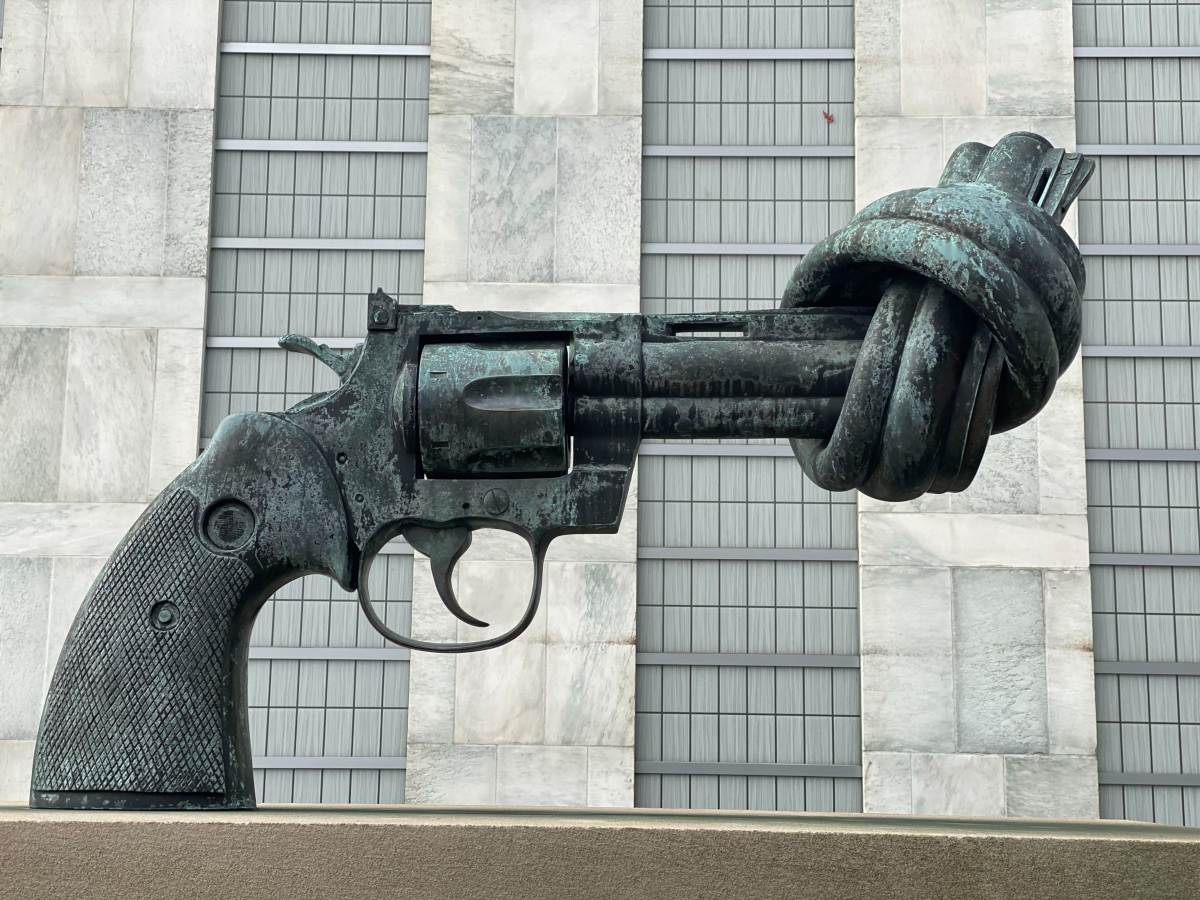Zoom into the crippling and crushing grief of any one parent of one of the slaughtered children in Uvalde and you will get a glimpse of the shattered soul of America.
Zoom out 1000x and you will get a sense of the enormity of the problem we are facing here.
We already knew that there is little justice in American criminal justice.
Now it is clear there is apparently little system in the American justice system.
After Uvalde, Buffalo, Sandy Hook, El Paso, Parkland etc. we know that the “system” is unable to prevent the unending tragedies that keep occurring with increasing frequency. It is not as though multiple organizations haven’t tried. Indeed, there are many mechanisms created to solve the gun problem in America; they just don’t seem capable of stopping the violence. Here are a few examples:
National Instant Check System is available to anyone. Just go to instantcheckmate.com and you can find information on any individual’s location, financial data, criminal records, social media profiles, etc. This is a commercial site that anyone can use to search for information on another person.
The National Instant Criminal Background Check System (NICS) is a system created by the Brady Handgun Violence Prevention Act of 1993 to prevent firearm sales to people prohibited under the act. The system was launched by the FBI in 1998 and requires background checks on prospective buyers before selling a firearm. It is not a gun registry but contains a list of persons prohibited from possessing a firearm. The buyer’s details are discarded after the query.
The National Suspicious Activity Report: Findings in the 9/11 Commission Report demonstrated the need for a nationwide capacity to share information that could prevent or deter a terrorist attack. The Intelligence Reform and Terrorism Prevention Act (IRTPA) of 2004 analyzes and distributes the information contributed by 18,000 law enforcement agencies related to emerging patterns or trends. The National Suspicious Activity Reporting (SAR) initiative was developed from this guidance. Suspicious activity is defined as behavior reasonably indicative of pre-operational planning associated with terrorism or criminal activity. This nationwide initiative is a collaborative effort among several federal agencies led by the Department of Homeland Security and the FBI. SAR has been publicly supported by major law enforcement associations.
The Predictive Policing System was deployed in 2017 in Cincinnati, Ohio, to detect gunshot activity. Predictive policing is software used by law enforcement to select neighborhoods or blocks where crime is likely to occur. For example, in one month the system detected 61 gunfire incidents in one neighborhood but only 5 resulted in a 911 call. The Chief of Police said that if it weren’t for “Shotspotter” (the gunfire detection system), police would not have known about 92 percent of the incidents.
The Homeland Security AI Strategy makes predictions, and decisions influencing real or virtual environments. (https://www.dhs.gov/sites/default/files/publications/dhs_ai_strategy.pdf)
AI presents opportunities for the Department of Homeland Security (DHS) to more effectively or efficiently accomplish the mission to secure the homeland. This makes it imperative for DHS to take a proactive role in the use of AI systems and to contribute to the national conversation on the secure use of this transformative technology. Efforts to secure the border, identify and interdict criminal actors, and secure cyberspace will be aided by use of AI systems.
Yes, there are several pistons pounding away in this criminal justice machine, but they are either out of sync or wildly inadequate to deal with the problems. The problem is not so much the lack of independent systems but the lack of interdependence among the systems. And, of course, there is no avoiding the facts:
- There have been 213 mass shootings in the US in the first 21 weeks of 2022.
- An average of 321 Americans are shot every single day
- Approximately 50,000 guns are sold every day.
- There are over 400 million guns in the US – 20 million of which are assault rifles.
- Over 10 million guns are manufactured each year in the US
- There are 42,000 gun related deaths each year.
- The US has 5% of the world population and owns 45% of the guns in the world.
- The US has at least 10 times the number of mass shootings than the country with the second most mass shootings (France).
Yes, it’s hard to hope. And it’s hard to deny that we have a problem unique to America.
Thoughts and prayers won’t change this.
I still believe there are several possibilities for making a difference that I summarize as the 7 C’s for preventing the repeat of horrific massacres we have recently witnessed and the stunning grief so many have had to experience.
-
Culture: America is still suffering from a culture of violence with roots in Native American genocide, slavery, and the wild west legacy personified by John Wayne and Ronald Reagan. The good thing about culture is that we can create norms of our own choosing. One small community in Michigan formed a Coalition of the Possible to deal with the lack of respect and civility that plagued public meetings. A group of citizens formed to inculcate the values of kindness, empathy, respect, collaboration, open-mindedness, inclusiveness, and honesty in their town. While this change requires constant care and feeding, progress is being made. Clearly, the US is in serious need of culture change.
-
Constitution: The second amendment needs to be overturned. Individual citizens do not have the rights to form unregulated militia groups with open carry assault weapons. As long as right wing extremist groups hide behind this sacred mantra, we will continue to suffer the consequences. The second amendment was never intended to protect what we are seeing today.
-
Congress: We need to change the composition of Congress. It is currently too polarized and broken to address the problems we are facing. In a recent article in the NYT, Ezra Klein argues that “democrats spend too much time and energy imagining policies that a capable government could execute and not nearly enough time imagining how to make a government capable of executing them.” No, democrats are not faultless. Republicans, on the other hand, have thrown away reason in order to rage and rave in a cult of regressive oppression. At end of the day, if we don’t vote extremist republicans out of Congress, nothing will change. Not only will they block any progressive legislation that would actually address the gun problems in America, but they will also continue to appoint ultra-conservative judges to the Courts that will give them air cover for their assaults on democracy. In short, as my friend Barry Cohen brilliantly suggests: “Republicans need to elevate, Democrats need to learn how to execute and both need to align on a higher missions. Keep out the radical and the inept.”
-
Costs: We need to start calculating the costs of crime and violence not only in economic terms, but also in mental health consequences. Our youth have never been so anxious and depressed. We still have no idea about the long-term consequences of the PTSD that our kids are suffering through. Unless we start focusing more on our future generations, we will continue to destroy whatever hope still remains.
-
Constraints: For starters, we need constraints on the NRA which continues to fund right wing politicians (it was the largest single contributor to the Trump campaign) and which lobbies most aggressively against any efforts on gun control. Their strategy is to divert the discussion about guns by creating the narrative that the problems are mental health, evil people, unarmed teachers, and liberals who want to take away their guns. And yes, as individuals, we need to exercise constraints in our own language and behavior.
-
Certifications: At a minimum, people need to pass rigorous background checks before buying a gun. Gun owners should also be trained in safety and earn a permit to use any weapon. Regulations reduced smoking and auto accidents; they can reduce gun violence as well.
-
Communications: Not only do all government and social service agencies need to communicate more effectively among themselves, but individuals also need to return to the kind of face-to-face interactions that build connections and decrease loneliness and alienation. Agencies need to close the information-action gap among themselves that collect and respond to information that may lead to a violent act. And all of us need to spend less time behind our screens and more time talking to friends and walking in Nature.
All of these actions will be hard, but none is impossible. Each one seems daunting in and of itself, but the consequences of not acting are devastating and debilitating.
Above all, what Uvalde did was reveal a cancer that has metastasized in America.
Band-aids won’t cure it. Wishful thinking won’t make it go away.
Denial will feed it.
We need to cure it. The seven C’s seem like a good place to start.
We need to create caring cultures, amend the constitution, vote intransigent republicans out of congress, take seriously the costs and consequences of PTSD in children, constrain right wing extremism, eliminate assault weapons, certify gun-owners based on thorough background checks and safety training, and start communicating genuinely, compassionately, and face-to-face.
Always additive, my friend Artie Vipperla summarizes: “The mega issues are institutional polarization, governmental sclerosis, and the orchestration of all of this by sources of funding even larger than the NRA.”
I believe consideration of some of these action recommendations would help us predict and prevent the kind of tragedies we are seeing all too frequently in America.
It seems to me that we spend too much time debating symptoms and too little time changing systems.
Once again we need to make the shift from competitive and independent individualism to collaborative and interdependent leadership.
How many more disasters will it take for that principle to sink in?
Also published on Medium.


